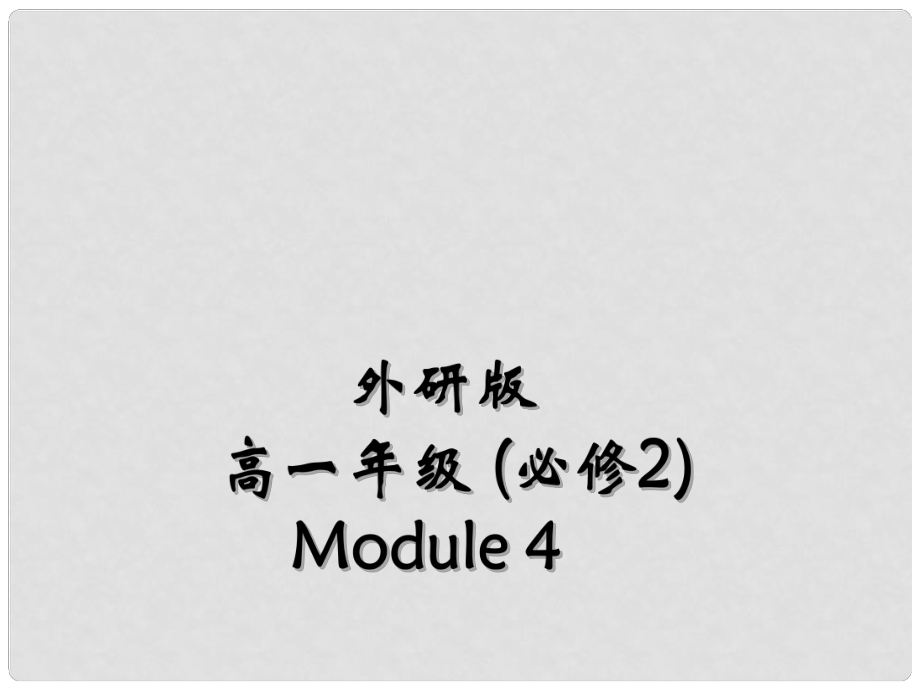《四川省古藺縣中學(xué)高中英語 Module4 Fine Arts—Western Chinese and Pop Arts Cultural corner課件 外研版必修2》由會員分享���,可在線閱讀�,更多相關(guān)《四川省古藺縣中學(xué)高中英語 Module4 Fine Arts—Western Chinese and Pop Arts Cultural corner課件 外研版必修2(24頁珍藏版)》請?jiān)谘b配圖網(wǎng)上搜索����。
1、課前準(zhǔn)備課前準(zhǔn)備Module 4-Fine ArtsHOMEWORK CHECKING(大聚焦大聚焦PG67).key words_ n. 破壞��;毀壞破壞��;毀壞.Key phrases:1. _ones _ twenties 在某人二十多歲早期時在某人二十多歲早期時2. a_ of 一系列一系列3. _ ones feelings _ 表示出對表示出對的感情的感情4. happen_ 碰巧��;發(fā)生碰巧����;發(fā)生. Key sentences 1.The boy said sadly: No one can tell _will _. 這個男孩悲傷地說:沒有人可以告訴你接下來會發(fā)生什么。這個男孩悲傷地
2��、說:沒有人可以告訴你接下來會發(fā)生什么。destroyinhappen whattoaboutshowearlyseriesA BEAUTIFUL SENTENCEArt is a lie that tells the truth. -(picasso, spanish painter) 美術(shù)是揭示真理的謊言��。美術(shù)是揭示真理的謊言���。(西班牙畫家西班牙畫家, 畢加索畢加索) Cultural cornerLEARNING AIMSTo learn something about Picasso.To practice our listening, reading and writing skill
3�����、s.To do some exercises. What is the main idea of this passage? Something about Picassos three periods and his paintings. 1. In 1881 _. 2. At the age of ten_. 3. At the age of 16_. 4. In his early twenties _. 5. From1902 to 1904 _. 6. From1904 to1906 _. 7.In1937_. 8. In 1973 _.Carefull readingRead ca
4�����、relly and write down the facts about Picasso according the time clues.1. In 1881 _.2. At the age of ten_.3. At the age of 16 _.he was born in Spain he was already an excellentartisthad his first exhibition4. In his early twenties _.5. From1902 to 1904 _.6. From1904 to1906 _.7.In1937_ _.8. In 1973 _.
5、moved to FrancePicassos blue periodPicassos pink periodhis greatest Cubist painting GUERNICAhe diedwas paintedLISTEN TO THE TEXT THEN CORRCT THE FOLLOWING PASSAGE People general agree that Pablo Picasso, he lived from 1881 to 1973, is the twentieth-centurys greatest western artist. He was born in Sp
6���、ain but at the age of ten was already a excellent artist. He had his first exhibition at the age of 16. Picasso studied art in Spain, but moved to French, in the early twenties. From 1902 to 1904 he painted series of pictures which the main colour was blue. These pictures had showed poor, unhappy pe
7����、ople and are known for Picassos “blue period.”generallywhoandanFrancehisawhereas或在which前面加in1. Picasso studied art in Spain, but moved to France, in his early twenties.年齡表示法年齡表示法1) 表示某人幾歲的表示某人幾歲的確切年齡確切年齡��,用��,用“基數(shù)詞基數(shù)詞years old”或或“基數(shù)詞基數(shù)詞years of age”或者或者“at the age of基數(shù)詞基數(shù)詞”�,也可直接用基數(shù)詞。,也可直接用基數(shù)詞����。a) 孩子們通常孩
8、子們通常7歲開始上學(xué)歲開始上學(xué)����。 Children usually start school at (the age of) seven. b) 她她70歲了。歲了����。 Shes thirty years old.= Shes thirty years of age.Language points2) 表示某人幾十多歲這樣的表示某人幾十多歲這樣的大約年齡大約年齡,用�����,用“in ones+基數(shù)詞的復(fù)數(shù)基數(shù)詞的復(fù)數(shù)(如如tens, twenties, thirties 等等)”來表達(dá)��。來表達(dá)��。a) 他他30多歲時去了美國��。多歲時去了美國�。 He went to America in his thir
9、ties.b) 他在五十歲出頭��、接近六十歲時開始有規(guī)律的他在五十歲出頭、接近六十歲時開始有規(guī)律的 進(jìn)行體育鍛煉��。進(jìn)行體育鍛煉����。 He started to take regular exercise in his early / late fifties. in his early twenties 在他二十初頭的時候在他二十初頭的時候 in ones early twenties 二十初頭二十初頭3) 表示年代表示年代 表示在某個世紀(jì)的表示在某個世紀(jì)的幾十年代幾十年代,用����,用“in the +基數(shù)基數(shù)詞的復(fù)數(shù)詞的復(fù)數(shù)”?����;鶖?shù)詞的復(fù)數(shù)若用阿拉伯?dāng)?shù)字表示�����,�����?�;鶖?shù)詞的復(fù)數(shù)若用阿拉伯?dāng)?shù)字表示��,可直接
10�、加可直接加 s,也可加也可加s�����。如如 “在在20世紀(jì)世紀(jì)80年代年代” 是是 in the 1980s或或 in the 1980s��,讀作讀作 in the nineteen eighties�����。注意:不要漏掉注意:不要漏掉 the��。a) 這條鐵路建于這條鐵路建于20世紀(jì)世紀(jì)70年代�。年代。 The railway was built in the 1970s. 2. From 1902 to 1904 he painted a series of pictures where the main color was blue. a series of 一系列�����,一連串一系列��,一連串1)a seri
11�����、es of pictures 一副又一副的畫一副又一副的畫 a series of good harvests 接連的豐收接連的豐收 a series of brilliant leaders 一個接一個的杰出一個接一個的杰出領(lǐng)袖領(lǐng)袖3. People agreed that Picassos greatest Cubist painting is Guernica, which was painted in Madrid in 1937. agree vt. vi. 1) 單獨(dú)使用,表示同意���、答應(yīng)等�。單獨(dú)使用����,表示同意、答應(yīng)等���。 我請求他幫忙��,他答應(yīng)了��。我請求他幫忙���,他答應(yīng)了。 I aske
12���、d him to help me and he agreed. 經(jīng)過了短暫的討論,這項(xiàng)計(jì)劃大家都同意了����。經(jīng)過了短暫的討論��,這項(xiàng)計(jì)劃大家都同意了��。 After a short time of discussion, the program was agreed. 2) 跟介詞跟介詞with連用連用. 表示表示“同意��;贊成同意�����;贊成”���; “與與一致;一致����;(氣氣候,食物候�����,食物) 適合適合”�����。 例如:例如: 我很同意你說的�����。我很同意你說的。 I quite agree with what you said. 我不太同意他所說的話�。我不太同意他所說的話。 I dont quite agree wit
13��、h what he said. 3) 跟介同跟介同to連用��,表示連用�,表示 “ 同意;贊成同意�����;贊成 (表示提議�����、安排�����、計(jì)劃表示提議��、安排���、計(jì)劃等的名詞等的名詞)”����。 我同意這個提議我同意這個提議(計(jì)劃計(jì)劃)���。 I agree to the proposal (the plan). 贊成這個安排嗎���?贊成這個安排嗎? Do you agree to this arrangement�? 我很同意他們的建議。我很同意他們的建議�����。 I quite agree to their suggestions. 4) 與介詞與介詞on連用��,表示連用����,表示“對對取得一致取得一致意見意見” (主語往往是協(xié)商一件事的
14、人們或主語往往是協(xié)商一件事的人們或單位�����,后面常接表示具體協(xié)議的文件、單位�����,后面常接表示具體協(xié)議的文件����、計(jì)劃、行動等名詞計(jì)劃����、行動等名詞)。例如:���。例如: 下次會議的日期達(dá)成了一致的協(xié)議��。下次會議的日期達(dá)成了一致的協(xié)議��。 The date for the next meeting was agreed on. 他們一致同意第二天到那里去�����。他們一致同意第二天到那里去���。 They agreed on going there the following day.agree with:表示表示“同意��;贊成同意;贊成” 某人某人說的����;說的;agree to : 表示表示 “ 同意��;贊成同意��;贊成 (表示提
15����、表示提議、安排����、計(jì)劃等的名詞議、安排����、計(jì)劃等的名詞)”。agreed on :表示表示“對對取得一致意見取得一致意見”達(dá)成了一致的協(xié)議���。達(dá)成了一致的協(xié)議��。agree to do sth :同意做某事:同意做某事4. In this painting, Picasso showed his feelings about what had happened to the town. 在那副畫里��,畢加索展示出了他對那在那副畫里���,畢加索展示出了他對那 小城發(fā)生的一切的小城發(fā)生的一切的情感情感�����。 feeling u 知覺知覺 c 態(tài)度態(tài)度, 看法看法; 感情感情1. Youve got it right
16�����、 means _. A. Youre correct B. Turn right2. Dont change a thing means _. A. Change people not things B. Dont change anythingABEveryday English3. Im not half as good as you means_. A. Youre much better than me B. Im almost as good as you 4. What do you make of( it )? Means_. A. What have you made? B. Whats your opinion of it?AB5. Theres (an exhibition) on means_. A. Theres an exhibition happening at the moment. B. An exhibition is starting soon6. Thanks for the compliment means_. A. Thanks for saying something nice about me. B. Thanks for doing thatAA
 四川省古藺縣中學(xué)高中英語 Module4 Fine Arts—Western Chinese and Pop Arts Cultural corner課件 外研版必修2
四川省古藺縣中學(xué)高中英語 Module4 Fine Arts—Western Chinese and Pop Arts Cultural corner課件 外研版必修2

